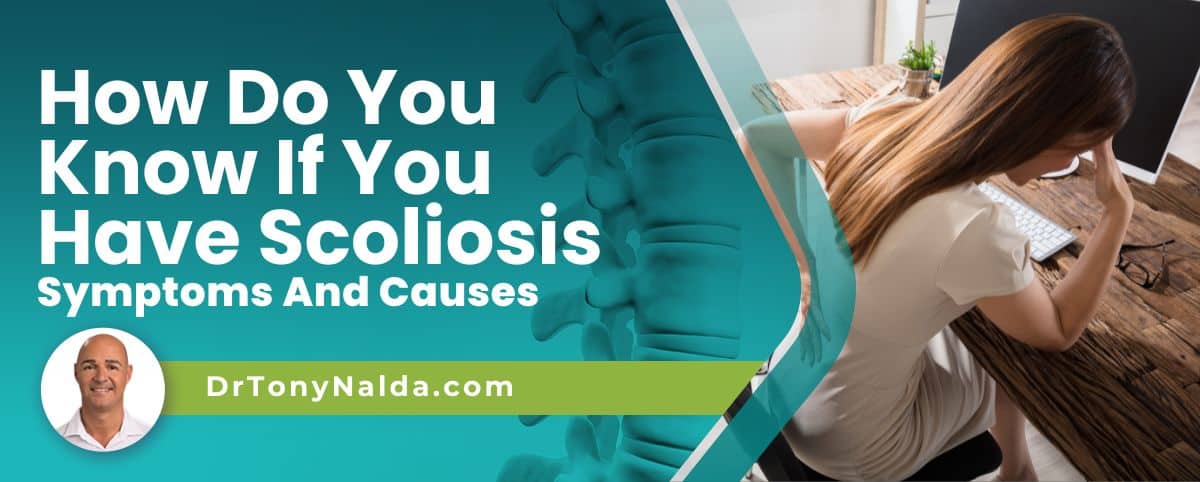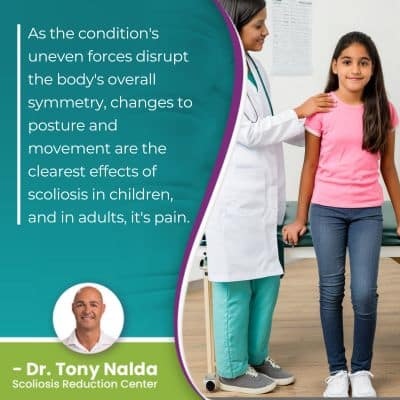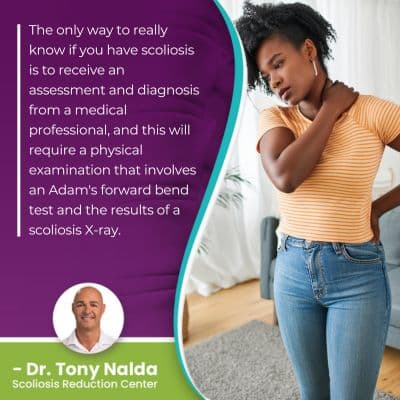How Do You Know If You Have Scoliosis: Symptoms And Causes

Scoliosis becomes a compressive condition once skeletal maturity has been reached, meaning growth has stopped, and this is when scoliosis tends to become painful; in addition, the more severe a patient's scoliosis is, the more noticeable its effects are likely to be. An X-ray is needed to reach a diagnosis of scoliosis.
There are different ways to tell if you have scoliosis, and the experience is different for children and adults. The main symptoms of scoliosis in children involve postural changes that disrupt the body's overall symmetry. The most common sign in adults is back and nerve pain.
Knowing the sometimes subtle signs of scoliosis to watch for can lead to early detection and intervention.
Table of Contents
Scoliosis is Progressive
Scoliosis causes the spine to develop an unnatural sideways bending and twisting spinal curve, and the spine needs its healthy curves to stay aligned, strong, flexible, and able to absorb mechanical stress.
In addition, as a progressive condition, the nature of scoliosis is to get more severe over time, and scoliosis ranges from mild scoliosis to moderate scoliosis, severe and very severe scoliosis.
So where a patient's scoliosis is at the time of diagnosis doesn't mean that's where it will stay, particularly if severe, if left untreated, or not treated proactively.
The worse scoliosis gets, the larger the unnatural spinal curve is, the more uneven forces there are being introduced to the body, and the more noticeable its; effects are going to be.
In many cases, it's more effective to proactively work towards preventing progression with treatment than it is to attempt to reverse its effects once they're established.
The more scoliosis progresses, the more complex it's going to be to treat; progression makes the spine increasingly rigid, less responsive to treatment, and can make it difficult for some patients to perform key therapeutic exercises as part of treatment.
So the more severe scoliosis is at the time of diagnosis, the more in need of treatment the patient is, and when detected and treated early, while there are no treatment guarantees, success is more likely.
So what has to happen to achieve early detection: the early signs of scoliosis have to be recognized, and this means understanding the condition's effects and symptoms.
Scoliosis Symptoms in Children
Scoliosis is a highly-prevalent spinal condition that affects all ages, but as the leading spinal condition among school-aged children, it should always be taken seriously.
 And as a progressive condition that's triggered by growth, children are at an elevated risk for rapid-phase and/or continued progression.
And as a progressive condition that's triggered by growth, children are at an elevated risk for rapid-phase and/or continued progression.
Adults still progress, but tend to do so at a slower rate, at least until the spine starts to naturally degenerate due to age.
In many cases of childhood scoliosis, the earliest signs are uneven shoulders and hips, and in addition, changes to balance, gait, and coordination are also common.
For children, scoliosis isn't commonly painful, so it can be difficult to achieve early detection, particularly in mild cases; postural changes can be subtle and functional deficits are rare.
There are never treatment guarantees, but when detected early and met with a proactive treatment approach, a focus of childhood scoliosis is counteracting progression during growth.
In addition to uneven shoulders and hips, postural changes to watch for in children can include:
- The head uncentered over the torso
- A crooked eye line
- Uneven shoulder blades
- The development of a rib cage arch
- An uneven waist line
- Arms and legs that hang at different lengths
As the condition's uneven forces disrupt the body's overall symmetry, changes to posture and movement are the clearest effects of scoliosis in children, and in adults, it's pain.
Scoliosis Symptoms in Adults
While scoliosis is more commonly diagnosed in children, it also affects adults; in fact, the actual rate of scoliosis increases in the aging population, and this is due to natural age-related spinal degeneration and the development of degenerative scoliosis.
The most common type of scoliosis to affect adults is idiopathic scoliosis, and these cases involve adults who developed their scoliosis during adolescence, but didn't receive a diagnosis or treatment, so their conditions progressed with time and maturity.
It's a common scenario that adults don't know they have scoliosis until it has progressed to a certain point, becoming compressive, and painful, and this speaks to the challenge of early detection.
Degenerative Scoliosis
The next most common type of scoliosis to affect adults is degenerative scoliosis, and this is common in adults over the age of 50 who are facing natural age-related spinal degeneration; this most often starts with the spine's intervertebral discs.
A disc sits between adjacent vertebral bodies, and the discs give the spine structure, flexibility, and act as the spine's shock absorbers.
When a disc starts to degenerate, it often becomes desiccated and changes shape as a result, affecting the position of adjacent vertebrae attached, disrupting the spine's ability to maintain its natural curves and alignment.
Scoliosis becomes compressive once skeletal maturity has been reached; in young patients who are still growing, the constant lengthening motion of a growing spine counteracts the compressive force of the unnatural spinal curvature, and it's compression of the spine and its surrounding muscles and nerves that causes the majority of condition-related pain.
Scoliosis Pain in Adults
Scoliosis pain in adults can involve muscle pain, back pain, and/or pain that radiates into the extremities due to nerve compression.
In most cases, it's nerve pain that brings adults in for a diagnosis and treatment. Nerve pain can be felt throughout the body, depending on the location of the scoliotic curve and the nerves within the spinal column that are affected.
There are three main sections of the spine: the cervical spine (neck), thoracic spine (middle/upper back), and the lumbar spine (lower back).
In most spinal conditions, and scoliosis is no exception, the area of the body located closest to the affected spinal section will be the most likely to feel its direct effects.
For example, in cases of lumbar scoliosis, a common complication is the development of sciatic nerve pain; the sciatic nerve starts in the lower back, and the unnatural spinal curve can compress and/or impinge the sciatic nerve within and/or where it exits the spine.
Compression
 Compression is uneven pressure, and if the sciatic nerve is compressed, it can cause pain felt anywhere along the sciatic nerve's extensive pathway that starts in the lower back and extends down the back of the hip, buttock, leg, and into the foot.
Compression is uneven pressure, and if the sciatic nerve is compressed, it can cause pain felt anywhere along the sciatic nerve's extensive pathway that starts in the lower back and extends down the back of the hip, buttock, leg, and into the foot.
Scoliosis back pain can be the worst around the curvature site, and this can involve a rigid spine; as scoliosis progresses, the spine's rigidity increases, making it less responsive to treatment and making it difficult for some patients to perform certain therapeutic exercises as part of treatment.
In addition, muscle pain is also common as muscular imbalances are another common scoliosis effect; the muscles that surround the spine can become unbalanced as they are pulled in different directions.
The muscles on one side of a scoliotic spine can become weak from underuse, while muscles on the other side can become stretched and sore from overuse, which is why a focus of scoliosis treatment is on increasing core strength through physical therapy so spinal support and stabilization is improved.
Conclusion
The only way to really know if you have scoliosis is to receive an assessment and diagnosis from a medical professional, and this will require a physical examination that involves an Adam's forward bend test and the results of a scoliosis X-ray.
In order to receive a diagnosis of scoliosis, the spine's unnatural sideways-bending and rotating spinal curve with a minimum Cobb angle measurement of 10 degrees is confirmed via X-ray imaging.
It can be helpful, however, to know the condition's early signs to watch for, particularly in children, as this can lead to early detection and intervention.
When treatment is started early in a condition's progressive line, there are fewer limits to what can be achieved.
The earliest signs of scoliosis in children are postural changes, while the earliest signs of scoliosis in adults is often pain once the condition becomes compressive.
When treatment is started early and progression of the spinal curve is prevented, scoliosis surgery can be avoided; spinal fusion is a costly, invasive, and risky procedure, and the reality is that many cases of scoliosis can be treated without surgery.
Here at the Scoliosis Reduction Center, I customize my treatment plans to address specific variables of each patient's condition as no two cases are the same; the complex nature of scoliosis necessitates the complete customization of effective treatment plans.
Dr. Tony Nalda
DOCTOR OF CHIROPRACTIC
After receiving an undergraduate degree in psychology and his Doctorate of Chiropractic from Life University, Dr. Nalda settled in Celebration, Florida and proceeded to build one of Central Florida’s most successful chiropractic clinics.
His experience with patients suffering from scoliosis, and the confusion and frustration they faced, led him to seek a specialty in scoliosis care. In 2006 he completed his Intensive Care Certification from CLEAR Institute, a leading scoliosis educational and certification center.
About Dr. Tony Nalda
 Ready to explore scoliosis treatment? Contact Us Now
Ready to explore scoliosis treatment? Contact Us Now





